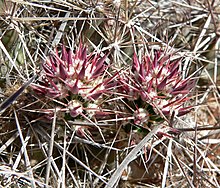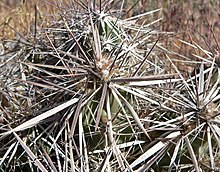
A cactus is a member of the plant family Cactaceae, a family of the order Caryophyllales comprising about 127 genera with some 1,750 known species. The word cactus derives, through Latin, from the Ancient Greek word κάκτος (káktos), a name originally used by Theophrastus for a spiny plant whose identity is now not certain. Cacti occur in a wide range of shapes and sizes. They are native to the Americas, ranging from Patagonia in the south to parts of western Canada in the north, with the exception of Rhipsalis baccifera, which is also found in Africa and Sri Lanka. Cacti are adapted to live in very dry environments, including the Atacama Desert, one of the driest places on Earth. Because of this, cacti show many adaptations to conserve water. For example, almost all cacti are succulents, meaning they have thickened, fleshy parts adapted to store water. Unlike many other succulents, the stem is the only part of most cacti where this vital process takes place. Most species of cacti have lost true leaves, retaining only spines, which are highly modified leaves. As well as defending against herbivores, spines help prevent water loss by reducing air flow close to the cactus and providing some shade. In the absence of true leaves, cacti's enlarged stems carry out photosynthesis.

Cylindropuntia imbricata, the cane cholla, is a cactus found in the Southwestern United States and northern Mexico, including some cooler regions in comparison to many other cacti. It occurs primarily in the arid regions of the Southwestern United States in the states of Kansas, Oklahoma, Texas, New Mexico, Arizona, Colorado, and Nevada. It is often conspicuous because of its shrubby or even tree-like size, its silhouette, and its long-lasting yellowish fruits.

In 1984, the International Organization for Succulent Plant Study set up a working party, now called the International Cactaceae Systematics Group, to produce a consensus classification of the cactus family, down to the level of genus. Their classification has been used as the basis for systems published since the mid-1990s. Treatments in the 21st century have generally divided the family into around 125–130 genera and 1,400–1,500 species, which are then arranged in a number of tribes and subfamilies. However, subsequent molecular phylogenetic studies have shown that a very high proportion of the higher taxa are not monophyletic, i.e. they do not contain all of the descendants of a common ancestor. As of August 2023, the internal classification of the family Cactaceae remained uncertain and subject to change. A classification incorporating many of the insights from the molecular studies was produced by Nyffeler and Eggli in 2010.

Cylindropuntia is a genus of cacti, containing species commonly known as chollas, native to northern Mexico and the Southwestern United States. They are known for their barbed spines that tenaciously attach to skin, fur, and clothing. Stands of cholla are called cholla gardens. Individuals within these colonies often exhibit the same DNA, as they were formerly tubercles of an original plant.

Pereskiopsis is a genus of cactus in the subfamily Opuntioideae. Unlike typical cacti, it has persistent fleshy leaves. The genus name refers to its resemblance to the genus Pereskia. Most species are found in Mexico south through Guatemala to Honduras, with one species in Bolivia. The incorrect spelling Peireskiopsis has also been used.
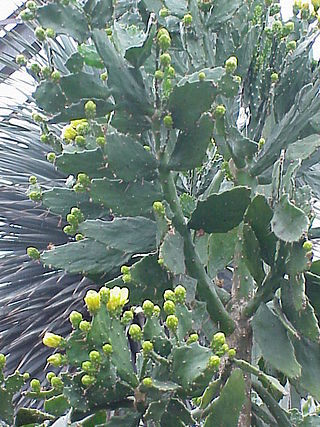
Brasiliopuntia is a genus in the cactus family, Cactaceae. It contains only one species, Brasiliopuntia brasiliensis.
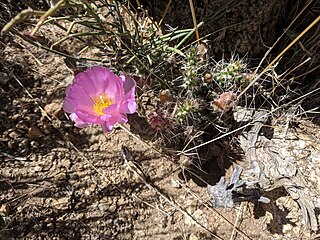
Micropuntia is a monotypic genus of cactus. Its only species is Micropuntia pulchella, synonym Grusonia pulchella. The species is also known as sagebrush cholla. It is a tuberous species of opuntioid cactus from the Mojave Desert of central Nevada, eastern California, northwestern Arizona and western Utah in the United States.

Echinocereus engelmannii, the strawberry hedgehog cactus or Engelmann's hedgehog cactus, is a cactus commonly found in desert areas of the southwestern United States and the adjacent areas of Mexico, including the states of California, Nevada, Utah, Arizona, Baja California and Sonora.

Opuntioideae is a subfamily of the cactus family, Cactaceae. It contains 15 genera divided into five tribes. The subfamily encompasses roughly 220–250 species, and is geographically distributed throughout the New World from Canada, to Argentina. Members of this subfamily have diverse habits, including small geophytes, hemispherical cushions, shrubs, trees, and columnar cacti consisting of indeterminate branches or determinate terete or spherical segments.

Opuntia humifusa, commonly known as the devil's-tongue, eastern prickly pear or Indian fig, is a cactus of the genus Opuntia present in parts of the eastern United States and northeastern Mexico.

Opuntia robusta, the wheel cactus, nopal tapon, or camuesa, is a species of cactus in the family Cactaceae. It is native and endemic to central and northern Mexico to within 100 miles (160 km) of the Arizona and New Mexico borders where it grow from 5,000 to 10,000 feet on rocky slopes, open shrub lands, woodlands and mixed with other cactus and succulents.

Cylindropuntia echinocarpa is a species of cactus known by the common names silver cholla, golden cholla, and Wiggins' cholla. It was formerly named Opuntia echinocarpa.

Grusonia parishiorum is a species of cactus known by the common names matted cholla and Parish club cholla. It is native to the Mojave and Sonoran Deserts of California and Arizona.
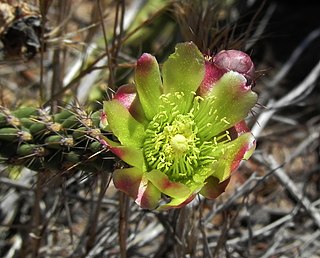
Cylindropuntia californica is a species of cholla cactus known by the common name snake cholla. It is primarily found in Baja California, Mexico and the southernmost part of California in the United States. It is characterized by a short, decumbent habit, yellow-green flowers, elongated stems, and short spines. It is mostly found in coastal sage scrub and coastal chaparral habitats, but two varieties in Baja California can be found in foothills and deserts. In California, variety californica is regarded as a rare and threatened plant, with a California Native Plant Society listing of 1B.1, in part due to its limited number of occurrences and threats from development. It formerly was considered to have a larger range due to the inclusion of Cylindropuntia bernardina within it as the variety parkeri.

Dactylopius is a genus of insect in the superfamily Coccoidea, the scale insects. It is the only genus in the family Dactylopiidae. These insects are known commonly as cochineals, a name that also specifically refers to the best-known species, the cochineal. The cochineal is an insect of economic and historical importance as a main source of the red dye carmine. It has reportedly been used for this purpose in the Americas since the 10th century. Genus Dactylopius is also important because several species have been used as agents of biological pest control, and because several are known as invasive species.

Leuenbergeria is a genus of flowering plant in the family Cactaceae, mostly native around the Caribbean. Unlike most cacti, it has persistent leaves and develops bark on its stems early in its growth. The genus was created in 2012 by Joël Lodé. Before the creation of Leuenbergeria as a genus, the species within it were included in a broadly circumscribed genus, Pereskia. Leuenbergeria is the only genus in the subfamily Leuenbergerioideae.

Cylindropuntia molesta is a cactus species that is endemic to Baja California state in Mexico.
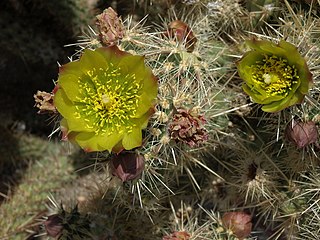
Cylindropuntia bernardina is a species of cholla cactus commonly known as the cane cholla or valley cholla, native to California and northwestern Baja California. It is an erect cholla that grows up to 2–3 meters tall, and occurs primarily in the foothills of the Transverse and Peninsular Ranges, parts of the Sonoran Desert, and in the Coast Ranges with a few populations around the Cuyama River. It was formerly placed as the variety parkeri of Cylindropuntia californica until it was renamed to C. bernardina. It is more closely related to Cylindropuntia ganderi than to C. californica.

Cochemiea poselgeri is a species of Cochemiea found in Mexico

Echinocereus brandegeei is a species of cactus native to Mexico.
